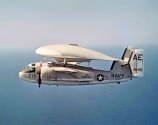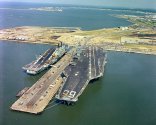So this was the full-version of the aircraft they were speculating about. Significant, but still a bit of a let down.
You are using an out of date browser. It may not display this or other websites correctly.
You should upgrade or use an alternative browser.
You should upgrade or use an alternative browser.
KJ-600 carrierborne AEWC thread
- Thread starter Blitzo
- Start date
building a AWACS Is hard enough
building a AWACS for a small plane is harder
building a AWACS and landing it on a warship at sea is even harder
only US has really managed it
Naval fixed wing AWACS is nothing short of a fully blown space program
Yeah...no. Actually it's almost exactly the opposite.
The first AEW aircraft were night fighters during WW2 and USN used Grumman Avenger bombers with radars in AEW roles. But if we are talking about "proper" AEW planes then land-based EC-121 Warning Star flew in 1949 and carrier-based E-1 Tracer flew in 1956.
This is E-1

E-2 Hawkeye flew in 1960 while E-3 Sentry only in 1972. Americans have been using numerous carrier-borne AEW aircraft fo over a decade until they moved to a larger plane and it was primarily caused by the development of radar technology which allowed to put a long-range radar on a large airframe. Before that the radars would be too cumbersome due to technological limitations.
Soviets weren't far behind with land-based AEW aircraft and Tu-126 flew in 1962. The USSR never developed a carrier-based AEW plane because they never built an aircraft carrier that was used in the same manner as US carriers. Kiev and Kuznetsov-class ships were meant to provide air cover for the SSBN "bastion" in the Arctic. They would never operate outside of range of land-based AEW planes and would never leave without powerful escort. The Americans needed carrier-based AEW because unlike the Soviets they were by default operating in the middle of the ocean securing lines of communication.
There is nothing challenging in the design of carrier-borne AEW plane as long as you have a carrier to test the structural requirements. It is the plane that is the real challenge not the radars. This is the kind of knowledge that is always an "industry secret" that nobody shares. This is for example why Russian MiG-29K is a horrible carrier-borne fighter and the Su-33 is only slightly better. Russians never used a proper carrier and so they had to guess all the long-term problems that Americans knew from their years of experience. This is why India doesn't have working aircraft for their carrier, and Russia deploys the planes from land bases in the Arctic.
Another reason is that nobody outside of the US Navy really used sufficient number of aircraft carriers to ever need their own AEW plane. Any R&D is expensive because it's looking for answers in the dark with the trial-and-error method. Military R&D is a budget drain because in the name of national security you can bill everything with a 500% markup. So countries avoid doing it if they can buy it from somewhere else and the US was more than happy to sell it. In fact it was rather angry if you didn't want to buy it.
The US had a reason to have its own plane because in the 1960s USN had over 20 carriers and reduced it to 14 in the 1970s. Britain had six. France had two. Everyone else had fewer. Also the USN had supercarriers starting with the Forrestal class while everyone else had an equivalent of Midway-class.
This is HMS Ark Royal - the largest carrier in RN service - and the USS Nimitz.

Those ships carrier fewer planes and allowed for a smaller operational radius. They didn't need AEW planes which at the time server primarily as forward sensors for offensive aircraft groups. That AEW was for aircraft flying far away from the ships, not for the aerial overwatch as we think of it today. It wasn't until recently that someone realized that ships can have better use of airborne sensors than even the best ship-based radar and again it was only due to technological developments that made it possible to put really good radars on planes. It was not possible to have an airborne radar that had the capability of AN/SPY-1 until AESA radars entered service.
And even so it's more difficult to build a carrier-based jet because jets operate with different payloads and takeoff/landing speeds than turboprop transport planes.
The reason why KJ-600 took so long was because it was a reasonable and practical decision to first develop a domestic AEW system on a land-based aircraft considering China's needs. China needs AEW over its territory and not over the middle of the ocean. When it has a carrier that is capable of going into the middle of the Pacific and deploying a fighter wing then it will need carrier-based AEW. And when it needs carrier-based AEW it will get it because once you have carriers, carrier-based fighters and land-based AEW it's not at all difficult. You've solved the hard piece of the puzzle. Putting them together is not that hard.
At this time in hitsory, i prefered the Do-31 for Carrier-Operations; Transport, Tanker, AEW, ASWThe US had a reason to have its own plane because in the 1960s USN had over 20 carriers and reduced it to 14 in the 1970s. Britain had six. France had two. Everyone else had fewer. Also the USN had supercarriers starting with the Forrestal class while everyone else had an equivalent of Midway-class.
Last edited:
The new Soviet carrier had a rather interesting configuration since it had both catapults and ramp to launch aircraft. I wonder what advantages this configuration has over the traditional catapult-only configuration apart from having a ramp backup in case the catapults break down.The Soviet Union had plans for a large aircraft carrier and an airborne early warning aircraft. But before the plans could become a reality, the Soviet Union was history.
The British had
One advantage I could think is if the catapults malfunction they could still launch aircrafts from ski jump.The new Soviet carrier had a rather interesting configuration since it had both catapults and ramp to launch aircraft. I wonder what advantages this configuration has over the traditional catapult-only configuration apart from having a ramp backup in case the catapults break down.
